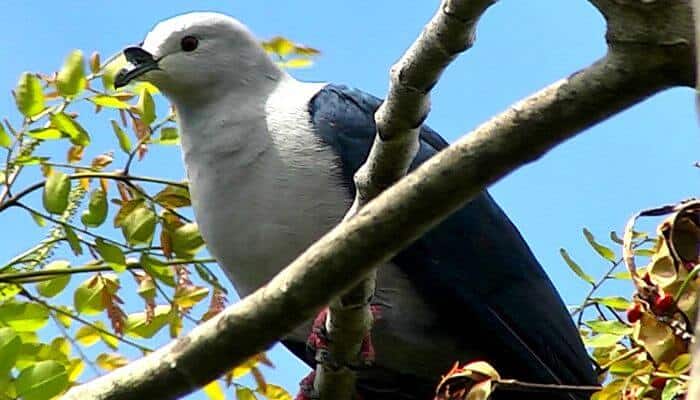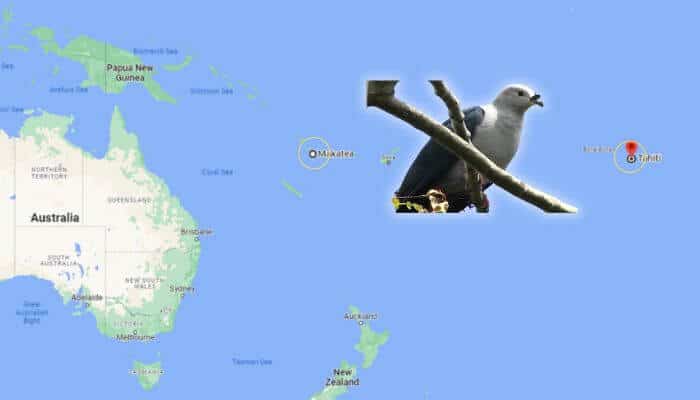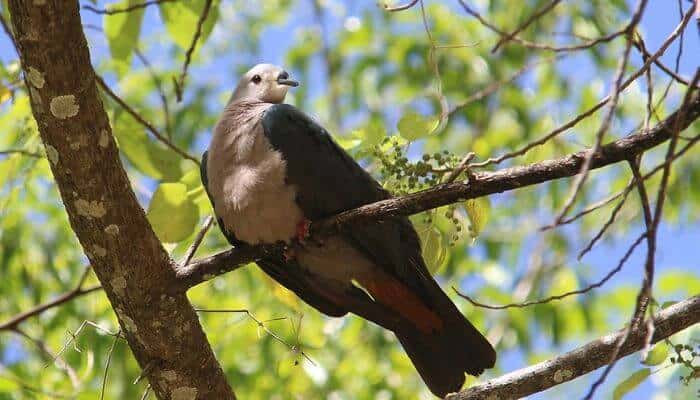The Polynesian Imperial Pigeon is also known as the Society Islands Pigeon and Tahiti Imperial Pigeon
This large wild pigeon species is endemic to French Polynesia and the remaining population is found on just one island.

The Polynesian Imperial Pigeon is one of 18 endangered pigeon species.
Origins of the Polynesian imperial pigeon
The Polynesian Imperial Pigeon (Ducula aurorae) was first described by American ornithologist Titian Peale in 1848.
At the time Peale described two populations, the Ducula aurorae wilkesii found in Tahiti and the Ducula aurorae found in Makatea.
He originally believed them to be separate taxa based on the number of tail feathers.
The Tahiti imperial pigeons had 12 tail feathers while the Makatea population had 14 tail feathers.
Aside from this there appeared to be no other differences between the species.
Distribution & Habitat of the Polynesian imperial pigeon
Polynesian Imperial Pigeons are found on Tahiti and Makatea islands.
However, the species is believed to be extinct in Tahiti where it was already restricted to the Papeno’o and Hitia’a valleys in the 1900s.

On Makatea there has been an increase in the population size.
In 1987 there were believed to be between 100-500 Polynesian Imperial Pigeons left. A survey in 2009 found there to be around 1,200 individuals.
Dense forest is the preferred habitat of the Polynesian Imperial Pigeon. They are most often found in subtropical and tropical moist lowland and montane forests.
While not their preference, habitat loss and degradation has meant the Polynesian Imperial Pigeon can now also be found in secondary habitats and occasionally gardens.
Closest Columbidae Relatives of the Polynesian imperial pigeon
The Polynesian Imperial Pigeon is part of the Ducula genus, or the imperial pigeon genus. There are 41 species within this genus. They are large – very large pigeons that mainly feed on fruit.
The most similar to the Polynesia Imperial Pigeon is the Pacific Imperial Pigeon:

The Pacific Imperial Pigeon is a similar species but is much more widespread, is smaller in size and has a different cere structure to the Polynesian Imperial Pigeon.
The male Pacific Imperial Pigeons do have a knob on the bill but the females do not.
The two species also have different calls making them easy to differentiate.
Polynesian imperial pigeon Appearance
The Polynesian Imperial Pigeon is a large pigeon with a light gray body and dark gray wings. The wings of this pigeon are broad and rounded.
The most distinctive feature of the Polynesian Imperial pigeon is the black fleshy knob above the bill. They also have a narrow white band around the base of their bill.
Although they are mainly gray in color, Polynesian Imperial Pigeons do have dark iridescent green upperparts, black primaries and black underwing. Their eyes, legs and feet are all red in color.
The males and females look alike however the males tend to be slightly larger in size.
Juvenile Polynesian Imperial Pigeons have dark brown/ black plumage, a less swollen cere on their bill and they have white feathers at the base of the bill.
When the juveniles molt they then develop intermediate plumage where their head and neck are grayish green and their underparts are dark gray. From this plumage they will then develop their adult feathers.
| Wingspan | Length | Weight | Coloring | |
|---|---|---|---|---|
| Polynesian imperial pigeon | Unknown | 41 – 51cm | Unknown | Mostly silver-gray with dark gray wings |
| Average Feral Pigeon | 64 – 72 cm | 32 – 37 cm | 300 – 500g | Bluish gray with some black |
Polynesian imperial pigeon Conservation
The Polynesian Imperial Pigeon is classified as endangered on the IUCN Red List.
There is not only a small population but these pigeons are found only in French Polynesia so they have a very small range with the estimated extent of occurrence being only 28 km2.
There are estimated to be between 570-1,200 Polynesian Imperial Pigeons left and the population is believed to be slightly increasing possibly thanks to reduced mining activity.
Threats to the Polynesian Imperial Pigeon population include habitat loss, particularly due to mining and road infrastructure, hunting, and predation by cats.
On islands that the Polynesian Imperial Pigeon formerly inhabited it is believed the Swamp Harrier (Circus approximans) played a role in the pigeon’s extinction.
The Swamp Harrier was intentionally introduced to Tahiti in order to control rat populations but this has impacted indigenous bird species including the Polynesian Imperial Pigeon.
Further spread of the Swamp Harrier could put the remaining pigeon population at risk.
Proposed conservation actions include:
- Resurveying the Polynesian Imperial Pigeon population
- Eradicating the Swamp Harrier (Circus approximans) to prevent the species from spreading to Makatea
- Opposing mining and runway plans on the islands
- Considering captive breeding and reintroduction onto Tahiti
Polynesian imperial pigeon Character
Polynesian Imperial Pigeons have a deep, hoarse cooing call.
When feeding, these pigeons are agile as they hop between branches looking for fruit. When in flight, they beat their wings slowly and occasionally glide.
Diet
These wild pigeons eat a variety of fruits, in particular they have been seen feeding on guavas, figs, and plantains.
Mating And Breeding Polynesian imperial pigeons
As Polynesian Imperial Pigeons are only found on Makatea, a mostly inaccessible island, very little is known about the species mating and breeding.
Caring for Polynesian imperial pigeons
The Polynesian Imperial Pigeon is an endangered species, this wild pigeon is not suitable for domestication.
As the biggest threat to the future of this species is habitat loss and degradation, the best way to help care for them is to support conservation efforts to protect the forests in French Polynesia.
There are ongoing threats to this species, in particular mining activities and the potential development of infrastructure such as roads.
As this species is found in such a small area protecting the remaining habitat is essential for their survival.
